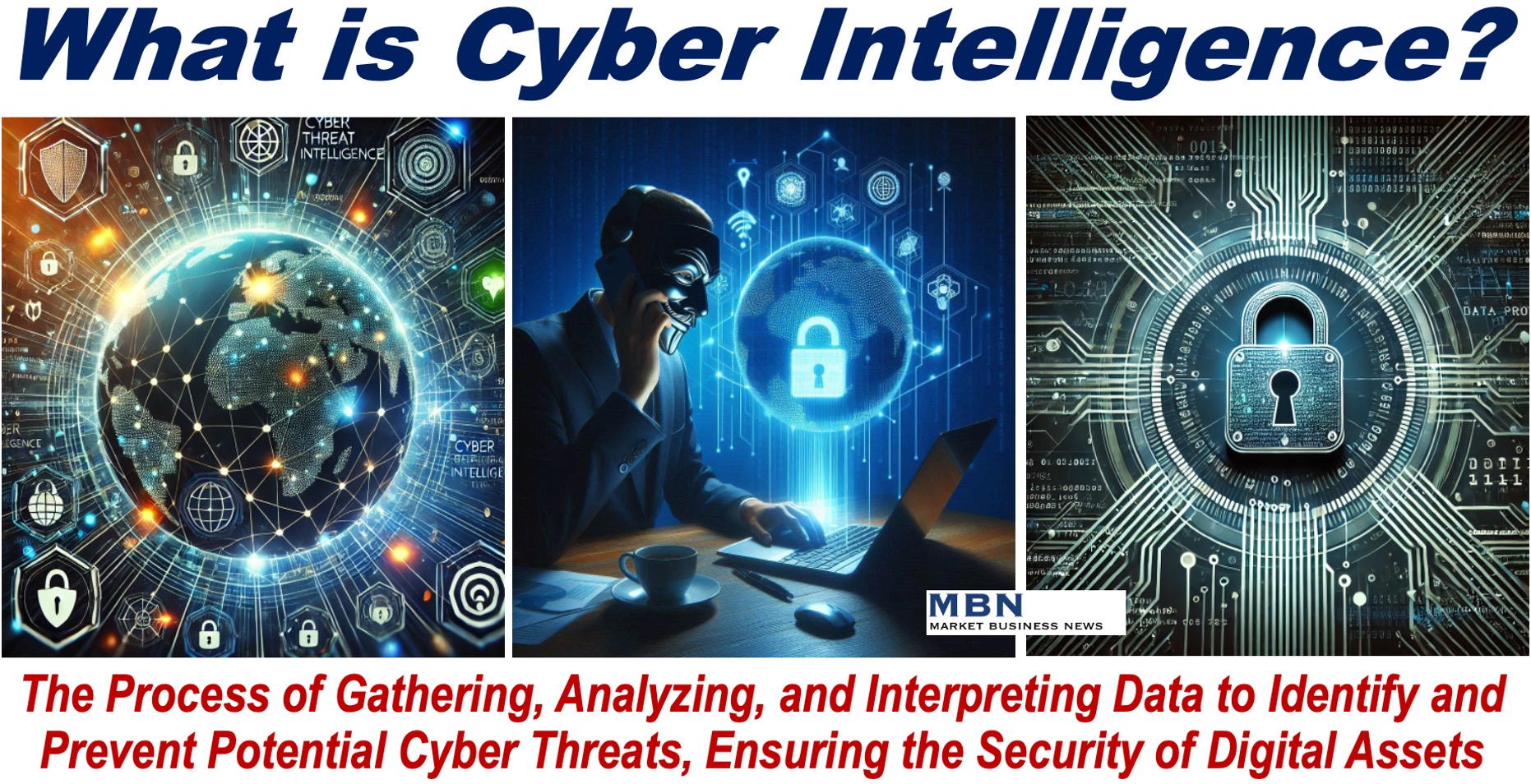Cyber intelligence or Cyber Threat Intelligence is the process of gathering, analyzing, and interpreting information about potential or existing threats in the digital world.
It involves understanding how cybercriminals operate and predicting their next moves, which helps you protect your digital assets, such as your business’s data, networks, and systems.
Microsoft.com has the following definition of ‘Cyber Threat Intelligence’:
“Cyber threat intelligence is information that helps organizations better protect against cyberattacks. It includes data and analysis that give security teams a comprehensive view of the threat landscape so they can make informed decisions about how to prepare for, detect, and respond to attacks.”
“Having focused information about actor behaviors, their tools and techniques, their exploits, the vulnerabilities they target, and emerging threats can help your organization prioritize its security efforts.”
Meaning of ‘Cyber’ and ‘Intelligence’
-
Cyber
The word cyber refers to anything related to computers, information technology, or the internet. It originates from the term “cybernetics,” which is the study of control and communication in animals, humans, and machines.
-
Intelligence
In the context of this article, the word intelligence specifically refers to the information or data that is gathered, analyzed, and used to understand and respond to potential or existing threats.
For spy organizations like the CIA in the US or MI6 in the UK, for example, intelligence refers to the data they collect and analyze to understand and counteract potential threats to national security.

Staying Ahead of Cyber Threats
In today’s connected world, cyber threats are constantly evolving. Cyber intelligence allows you to stay ahead of these threats by providing insights into the tactics, techniques, and procedures used by cyber attackers.
This intelligence is crucial for making informed decisions about how to defend your systems and data from potential breaches.
Cyber Intelligence – Gathering Relevant Data
Cyber intelligence is fundamentally about collecting relevant data from various sources. These sources can include online forums where hackers discuss their activities, dark web marketplaces where stolen data is sold, or even social media platforms where potential threats are identified.
This information is then analyzed to understand patterns and trends in cyber threats. By doing so, you can anticipate and counteract these threats before they cause harm.
Three Categories
Cyber intelligence is typically divided into three main categories: strategic, operational, and tactical:
-
Strategic intelligence
This category focuses on the big picture, helping you understand the overall threat landscape and its implications for your business, organization, or country.
For the rest of this article, when you see ‘business’ or ‘industry’ in this context, it also includes ‘organization’ and ‘country.’
-
Operational Intelligence
Operational intelligence is more about specific threats that are relevant to your organization, such as a particular type of malware targeting your industry.
-
Tactical Intelligence
Tactical intelligence is the most detailed, providing information about specific threats that need immediate attention.
Benefits
One of the key benefits of cyber intelligence is that it enables proactive defense. Instead of reacting to an attack after it happens, you can use intelligence to anticipate and prevent it.
This proactive approach can save you time, money, and the potential damage to your company’s *brand image or credibility that a cyberattack could cause.
The term brand image refers to the public’s perception of your company, including how customers and stakeholders view your products, services, and reputation.
Implementation
Implementing cyber intelligence in your organization involves several steps. First, you need to identify what assets you want to protect, such as sensitive customer data or proprietary business information.
Then, you must gather and analyze intelligence (data) to identify potential threats to those assets.
Finally, you can use this intelligence to shape and guide your cybersecurity strategies, ensuring that your defenses are robust and up-to-date.
Cyber Intelligence – A Brief History
-
Early 1990s
When the Internet became more prevalent and the potential for cyber threats increased, the concept of cyber intelligence began to take shape. At first, only people who worked in government and the military discussed the topic, particularly in the context of protecting national security and critical infrastructure.
-
After the Turn of the Century
By the mid-2000s, the concept spread to businesses, driven by growing cybercrime.
The 2010s marked the term’s widespread recognition across various industries, especially after high-profile cyber incidents like the 2007 Estonia attacks and the 2013 Snowden revelations.
While no specific individual coined the term “cyber intelligence,” it evolved naturally as cybersecurity and intelligence disciplines converged.
Today, it is a crucial element in organizational strategies for cybersecurity and risk management.
Other Forms of Intelligence
In addition to cyber intelligence, there are several other types of intelligence that are vital across various disciplines. Here are ten significant forms:
The natural cognitive ability that encompasses reasoning, problem-solving, learning, and adapting to different situations.
The capacity to effectively navigate social environments, understand interpersonal dynamics, and build strong connections with others.
The process of observing and analyzing market conditions to uncover trends, opportunities, and risks, aiding in better business planning.
Advanced technology that allows machines to mimic human cognitive functions such as learning, reasoning, and problem-solving.
The skill to identify, comprehend, and manage your own emotions as well as those of others to foster better relationships and decision-making.
The practice of collecting and analyzing data about competitors to achieve a strategic edge in the marketplace.
The collection and analysis of data to generate actionable insights that drive business strategy and enhance performance.
The analysis and understanding of economic data and trends to make informed financial and strategic business decisions.
The process of analyzing customer data to gain insights into their needs, behaviors, and preferences, supporting better decision-making.
Final Thoughts
In conclusion, cyber intelligence is an essential tool for protecting your business in the digital age.
By staying informed about potential threats and understanding how to defend against them, you can safeguard your valuable assets and maintain your organization’s security.
With cyber intelligence, you are better equipped to navigate the ever-changing landscape of cyber threats and protect what matters most to you.
